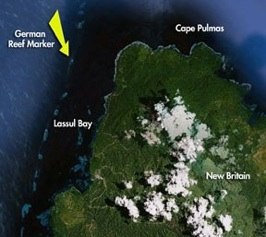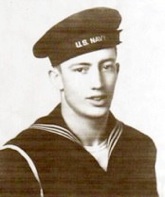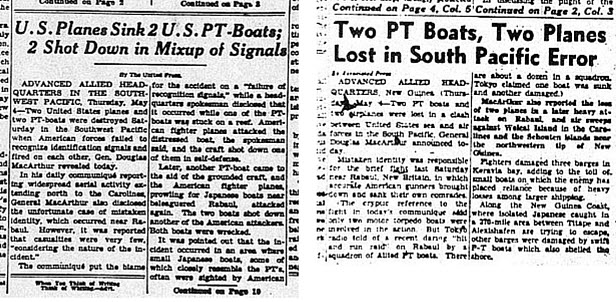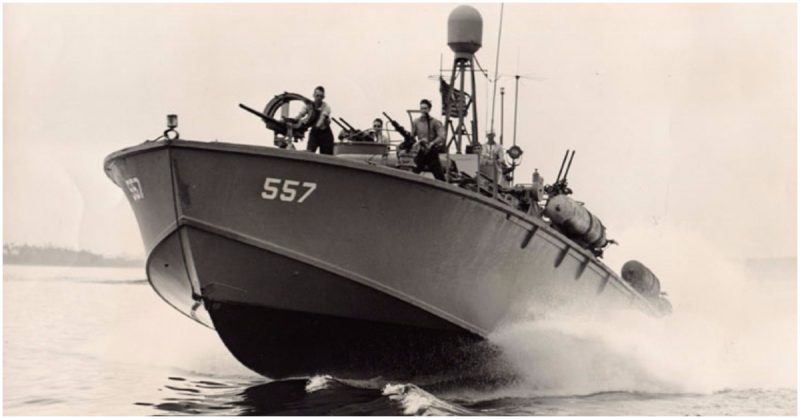Daniel Williams writes: My father’s story began early on the morning of April 29th, 1944 when during a mission aboard PT347 along with the PT350 to seek out any Japanese predawn traffic. His PT boat in which he was Skipper, the 347 runs up onto a reef at a location called Lassul Bay. This bay is located on the North/West corner of the island of New Britain on the Gazelle Peninsula. One and a half miles West of Cape Pulmas. In New Guinea. (later to be called Papua New Guinea)
The exact location of where this incident happened is very relevant. The U.S. military’s demarcation line dividing the South Pacific from the Southwest Pacific ran through Cape Lambert to the Northwest. The spot in which they ran aground was approximately six miles from this line.
What is also relevant to this tragedy is how good the weather was.
The weather was clear, the sea was calm, with a visibility of fifteen miles.
On the same morning of the 29th of April, 1944 there was another mission. Major James K. Dill, U.S. Marine Corps, led this mission. Dill and his three corsair’s mission were to strafe any targets of opportunity. One of the corsairs developed engine problems and was told by Dills to return to base with another plane for cover.
This left Major Dill and his wingman Lt. Cochran to strafe various targets along the shore of west ward towards Cape Pulmas then crossing the demarcation line. His wingman radioed that there were two ships ahead. Climbing to 6000 feet above AA fire the two planes started to dive on the targets, later saying, “there was no recognition signals of any kind.”
After strafing once and then circling once, Dills would not see his wingman Lt. Cochran again. Major Dill then dispatched to Green Island, “Ordering immediate Attack!” Returned to base informing the Squadron Intelligence Officer and pinpointing the location of the enemy gunboats.
After being briefed on the shipping strike, but also taking necessary precautions before sending the order to strike immediately, and to look out for any identification. 8 SBD’s, 6 TBF’s, and 4 F6F’s made up the strike. A Lieutenant Knite took the lead and led the flight to the boats. Lt. Knite failed to return from the strike and, to date, hasn’t been seen since.
Dills and three other corsairs mission orders were to circle above, and when the bombing was over, to search for his downed wingman. Instead after the bombs were dropped, they strafed the men in the water for up to 45 minutes.

After the 350 left, every effort was made to contact the U.S.S. Hilo, Dreger, Cape Cloucaster and Saidor. At approximately 0800 PT349 hooked up with and came to the aid of PT350. At approximately 1030, the 347 came in radio cDWG-1ontact with PT346. The 346 arrived to assist the 347 at approximately 1230 King.
At 1400 King, PT347 sighted planes northeast at about ten miles. After Lt. Williams notified Lt. Thompson of the 346 about the planes, Thompson replied “Those must be our air cover, so lets resume efforts to get the boat off the reef.”
After noticing that the planes were getting closer, Lt. Thompson made several unsuccessful attempts to communicate with the planes. Upon noticing two planes coming in on an apparent run, General Quarters was called. The planes began firing at the beginning of the run. The 347 fired several rounds at the attacking planes, while the radioman tried to communicate with the planes unsuccessfully. “Lt. Thompson and I (of the 346) unraveled a ten foot American flag that was held up on the day room, but they made their runs and fired just the same”. The first run taking off the legs of the radioman
Lt. Williams then orders all hands into the water. Everyone abandons ship. Wilbur Larson still firing his 20mm on the bow is the last off. Before abandoning ship he notices Forrest May (Forrest May was a Carpenters Mate that was just along for the ride) standing on the reef shouting at Wilbur that he couldn’t swim, and that he had been shot in the hand. After going over the side, Seaman Larson then took off his web belt and wrapped it around Forrest’s wrist and hand to hold on his severed thumb. Holding onto him and swimming during the whole attack, and pulling Forrest under water with him during the strafing. (My father would recommend that Wilbur Larson be decorated for this. He would receive the “Navy, Marine Medal” for his bravery)

Raymond Juneau
Refuses to abandon ship while shooting away with PT347’s twin 50s.
“Ray” is blown up with the boat.
Every attempt by the crew of the 347 were made to get off the reef and several attempts were made by PT350. At 0700 while the 350 was still attempting to tow the 347 off the reef, the crew of the 347 sighted two unidentified planes circling over a point assumed to be close to Cape Lambert. The OTC was notified immediately by radio. Both boats went into general quarters.
At approximately 0705, the two planes were sighted coming in from the west – distance approximately five miles, at about 5000 feet. The two planes opened fire at about two miles away. Lt. Williams ordered the crew to open fire.
In the meantime, the 350 proceeded into deeper water and also opened fire. The two planes made one pass and one plane was shot down and destroyed, falling into the water. The other plane circled overhead until disappearing.
No personnel or material casualties were suffered on the 347, but the 350 was hit several times and sustained three dead, and five wounded. She proceeded immediately to the base.
The two boats tried unsuccessfully to “raise” contact the unidentified planes, using daytime frequency, the PT347 blinked “S” and “V” with searchlight during the whole attack. Three officers waved their arms frantically. The 350 were also unsuccessful.
The two boats had the aircraft identification star painted on top of the chartroom canopy and also on top of the dayroom canopy. The larger one having a diameter of approximately seven feet. Both boats were flying the U.S. Ensign from the top of the radar mast and on the stern.
This would be just the beginning,…
Wilbur Larson isn’t the last one on PT347 after all. Seaman Raymond Juneau who is still firing away with the boat’s twin 50’s refuses to abandon ship. About three minutes had passed when a bomb made a direct hit on the 347 and blew her apart. After Lt. Williams looked over at the 346 and saw that she was burning furiously, and the TBF’s where still skip bombing and corsairs were strafing, he then ordered his men who were drifting towards the shore to “REMAIN DISPERSED”. My father also ordered everyone to take off their life jackets, place their helmets on top of them and dive under when the strafing started.
Four corsairs strafed the men in the water for approximately 45 minutes, this is what caused many of the casualties. One of the Officers who were killed was a Lieutenant Colonel Petitt; he was a *U.S. Army observer on the 346. Many witnessed his head blown off while he clung to a life raft after losing a lung.
After the attack while wading in the water, Lt. Williams gave Forrest May a shot of morphine. They were able to see, and identify the pilots’ faces as they banked their planes so they could try to see their handiwork. The attack ended at about 1530, at which time the four remaining corsairs headed east.
At about 1650 a Catalina was sighted with fighter cover heading in their direction. The fighters showed up flying wagging their wings. The Catalina flew over and dropped an inflated life raft. Ray Sequin, barely being able to see with his eyes still burning from oil, swam over to life raft, then rowing to the 347’s bow that was still sticking out of the water, he was able to get into the forward lockers and find a carton of cigarettes and a can of hard candy, they had to light the cigarettes off the smoldering bow. The rest of the survivors then rowed back over to the 347 where there is a beacon buoy (or reef stake, known to this day by the locals as the German Marker – Put there by Germany in the 1920’s). They tied up to the stake in the reef where they stayed for a long evening. I remember my father telling me about the campfires and talking they could see and hear close by in the jungle. PT’s 351 and 355 picked them up in the early hours and brought them back to the Hilo.
Out of the three boats involved,
14 seamen killed or missing (including U.S. Army Lt. Colonel Petitt) 14 seamen wounded
2 U.S.M.C. pilots killed
The demarcation line dividing the South Pacific from the Southwest Pacific is what separated General MacArthur from Admiral Nimitz who with large egos disliked each other intensely. Making it a rule for personnel not to cross over the other’s line without express authorization and a specified period of time. They were briefly brought together in some power struggle over the incident.
Nimitz was more powerful, both militarily and politically. Doug knew this to be true. The best thing he could do is leak this to the press.
(Although a small clip, It was front-page news across the country).
San Fransisco Conical & The L.A. Times

“I believe word came down from Nimitz: No marine will be indicted, prosecuted, or penalized due to this tragic accident. Case Closed!”
Capt. Dill would eventually retire as a Full Colonel.
Lt. Williams was retired from the navy at the age of 26, about a year after the incident
for being 50% mentally disabled do to post-traumatic syndrome.
By Daniel Williams, reproduced with permission
